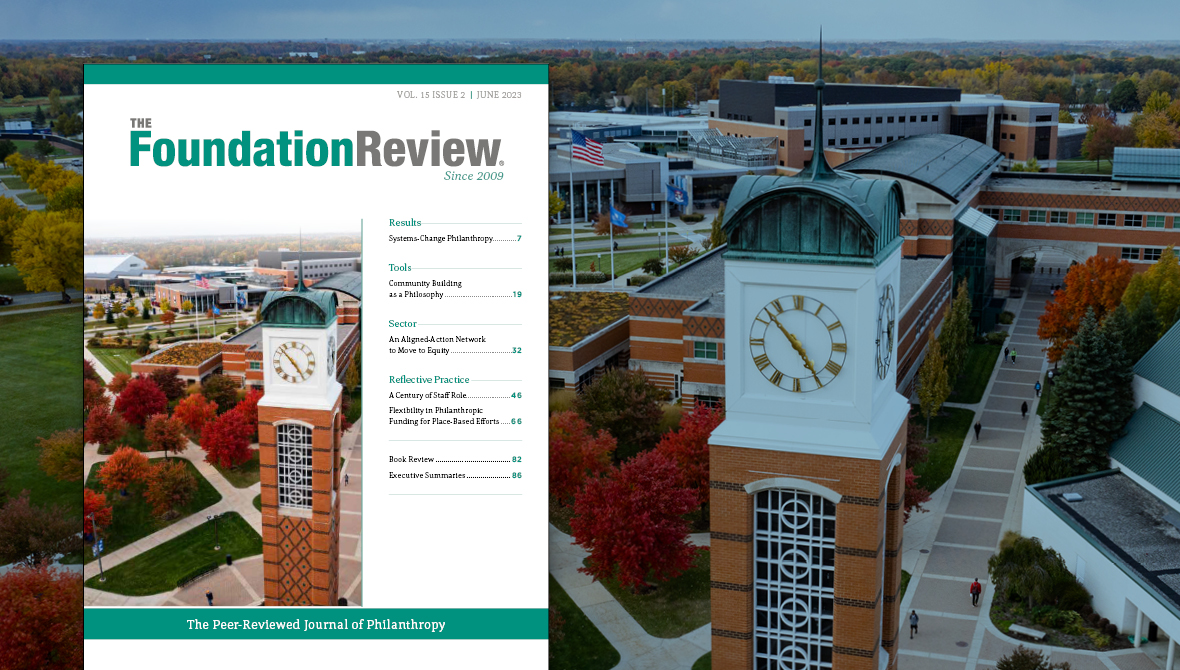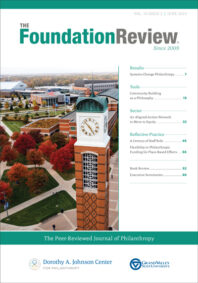Inside The Foundation Review, Vol. 15 Iss. 2


 This issue of The Foundation Review highlights examples of systems-change philanthropy, community-building philosophy, the evolution of foundation staff roles, place-based efforts, and more.
This issue of The Foundation Review highlights examples of systems-change philanthropy, community-building philosophy, the evolution of foundation staff roles, place-based efforts, and more.
It concludes with a review of the book, Changing Systems, Changing Lives: Reflecting on 20 Years, published by The Nicholson Foundation.
In this article, Bhandari, Boleware, and Martinez describe an ambitious and successful initiative of the Hogg Foundation for Mental Health to expand the pool of professionals with the skills to address mental health policy in Texas. The policy fellows worked in community organizations for the duration of the fellowship; many then moved on to leadership positions. As foundations have increasingly focused on systems change and sustainability, the importance of policy in creating and maintaining change has become clear, and models such as this for creating policy capacity are needed.
Place-based initiatives seem to be having something of a resurgence in the last few years. Kubisch, Allen, and Gimbel share how The Ford Family Foundation, a rural embedded funder in southern Oregon, adopted a community-building philosophy central to their work. The foundation’s bilingual Community Building Approach Wheel may be a useful tool for other foundations who are considering how place-based work might avoid the pitfalls of the last generation of such work.
Using data from interviews with foundation staff, network meeting observations, and network documents, Daniel, Dihn, and Paarlberg examine how community foundations define equity; what structures, processes, and activities were perceived as supporting their equity-related work; and how membership in an aligned-action network helped highlight these efforts. They found that the foundation focus (internal/external) and how they expressed their commitment (implicit/explicit) were important variables.
Whether or not philanthropy is a profession has been debated in the literature, but little attention has been given to foundations’ internal dynamics and how the roles of foundation staff have developed and evolved over time. Gartner, Jung, and Baluch synthesize research on the impact of philanthropic events on role evolution, demonstrating a movement from amateur traditions to emerging professional influences. Four areas of inquiry are presented for foundation practitioners and associations to explore: expertise, training, competencies, and policies. The debate may continue, but bringing research to the discussion is a welcome development.
In this article, Weitzman, Abrams, Starr, Hasan, Shire, Elbel, and Berry share insights and reflections from the Healthy Neighborhoods Initiative, a $22 million, six-year, place-based effort by two grantmaking foundations across nine diverse communities in New York state. They found that local partnership structures built on existing relationships and those that had or could quickly build trust of key actors and community residents were more effective at sustaining strategic activities and engagement. This article compliments the Kubisch et al. article, underscoring the importance of relationships and trust.
This issue concludes with a review of the book Changing Systems, Changing Lives: Reflecting on 20 Years. Musyoka, Irungu, and Sloan give a very positive review of this reflection on the mission and strategies of The Nicholson Foundation during its 20-year history of pursuing systems-level change for vulnerable populations. They note that the authors encourage a paradigm shift among foundations — from an in-perpetuity model to one of high-impact investing and the intentional spending down of assets — and show how The Nicholson Foundation accomplished that transition. As limited-life foundations continue to gain interest, this is a welcome addition to the literature on the topic.
Not yet a subscriber to The Foundation Review?
Start your free 90-day trial today!